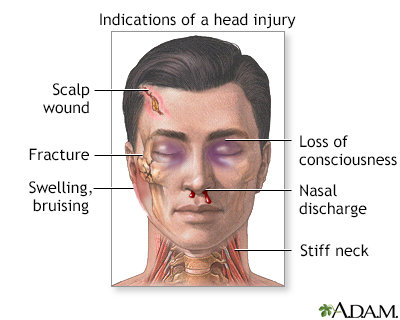Pregnancy SmartSiteTM
Brain injury; Head trauma; Concussion - head injury; Traumatic - head injury DefinitionA head injury is any trauma to the scalp, skull, or brain. Head injury can be either closed or open (penetrating).
Head injuries include:
Head injuries may cause bleeding:
Head injury is a common reason for an emergency room visit. A large number of people who suffer head injuries are children. Each year an estimated 1.5 million Americans sustain a traumatic brain injury (TBI). As a consequence of these injuries, 230,000 people are hospitalized and survive. CausesCommon causes of head injury include:
Most of these injuries are minor because the skull protects the brain. Some injuries are severe enough to require a stay in the hospital. SymptomsHead injuries may cause bleeding in the brain tissue and the layers that surround the brain (subarachnoid hemorrhage, subdural hematoma, epidural hematoma). Symptoms of a head injury can occur right away or may develop slowly over several hours or days. Even if the skull is not fractured, the brain can hit the inside of the skull and be bruised. The head may look fine, but problems could result from bleeding or swelling inside the skull. The spinal cord is also likely to be injured from falls from a significant height or ejection from a vehicle. Some head injuries cause changes in brain function. This is called a traumatic brain injury. A concussion is a type of traumatic brain injury. Symptoms of a concussion can range from mild to severe. First AidLearning to recognize a serious head injury and give basic first aid can save someone's life. For a moderate to severe head injury, call 911 or the local emergency number right away. Get medical help right away if the person:
Then take the following steps:
Do NotFollow these precautions:
A serious head injury that involves bleeding or brain damage must be treated in a hospital. For a mild head injury, no treatment may be needed. However, contact your provider for medical advice and watch for symptoms of a head injury, which can show up later. Your provider will explain what to expect, how to manage any headaches, how to treat your other symptoms, when to return to sports, school, work, and other activities, and signs or symptoms to worry about.
Both adults and children must follow their provider's instructions about when it will be possible to return to sports. When to Contact a Medical ProfessionalCall 911 or the local emergency number right away if:
PreventionNot all head injuries can be prevented. The following simple steps can help keep you and your child safe:
ReferencesHockenberry B, Pusateri M, McGrew C. Sports-related head injuries. In: Kellerman RD, Rakel DP, eds. Conn's Current Therapy 2023. Philadelphia, PA: Elsevier; 2023:810-814. Hudgins E, Heman-Ackah SM, Grady MS. Initial resuscitation, prehospital care, and emergency department care in traumatic brain injury. In: Winn HR, ed. Youmans and Winn Neurological Surgery. 8th ed. Philadelphia, PA: Elsevier; 2023:chap 386. Papa L, Goldberg SA. Head trauma. In: Walls RM, ed. Rosen's Emergency Medicine: Concepts and Clinical Practice. 10th ed. Philadelphia, PA: Elsevier; 2023:chap 33. | ||
| ||
Review Date: 11/2/2023 Reviewed By: Jesse Borke, MD, CPE, FAAEM, FACEP, Attending Physician at Kaiser Permanente, Orange County, CA. Also reviewed by David C. Dugdale, MD, Medical Director, Brenda Conaway, Editorial Director, and the A.D.A.M. Editorial team. View References The information provided herein should not be used during any medical emergency or for the diagnosis or treatment of any medical condition. A licensed medical professional should be consulted for diagnosis and treatment of any and all medical conditions. Links to other sites are provided for information only -- they do not constitute endorsements of those other sites. No warranty of any kind, either expressed or implied, is made as to the accuracy, reliability, timeliness, or correctness of any translations made by a third-party service of the information provided herein into any other language. © 1997- A.D.A.M., a business unit of Ebix, Inc. Any duplication or distribution of the information contained herein is strictly prohibited. | ||


 Concussion
Concussion Bicycle helmet - p...
Bicycle helmet - p... Head injury
Head injury Intracerebellar he...
Intracerebellar he... Indications of hea...
Indications of hea...
